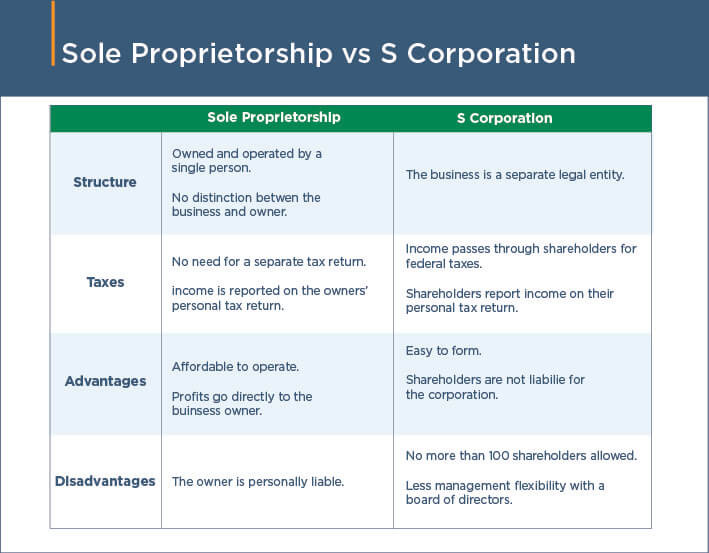Before you start raising capital, you’ll need to make a key decision as a business owner. You’ll need to figure out which form of business will best serve you and your company. The majority of U.S. businesses—about three-quarters of them—choose a sole proprietorship.
Alternatives to a sole proprietorship include incorporating into an S corporation or a C corporation or forming a limited liability company (LLC). These other structures each provide their own unique attributes and benefits and will generally shield your personal assets from the business’s legal liability—something a sole proprietorship won’t do. That said, being a sole proprietor comes with its own advantages to consider.
Given today’s challenging economic climate with COVID-19, it’s important to weigh the pros and cons of all the business structures. Choosing the right business structure can affect your ability to find investors and attract customers. It also impacts how much you spend to run your business, how you pay taxes and how legally protected you are.
Read on to learn more about the ins and outs of being a sole proprietor.
What Is a Sole Proprietorship?
A lot of small businesses may ask, “What is a sole proprietorship?” The sole proprietorship definition is a business owned by one person where there’s no legal separation between the business and the owner. That means if the business gets sued, the owner can be held financially liable and may have to pay legal defense costs and settlement money using their personal assets.
At the same time, a sole proprietorship is by far the simplest type of business to start and operate. This is because you don’t have to jump through all the hoops that incorporation entails, such as filing paperwork annually with your state and complying with the procedural rules of incorporation.
Many business owners—especially solo entrepreneurs without employees—choose to remain sole proprietors and not incorporate because of the simplicity.
What Makes a Sole Proprietorship Unique?
There are several key traits that set sole proprietorships apart from other types of business structures:
- Simplicity: Compared to other types of business structures, sole proprietors are generally required to file very little (if any) paperwork with their state government or adhere to particular protocols.
- Affordability: A sole proprietorship is typically the least expensive type of business to start and operate due to the limited amount of reporting required. By comparison, if you form a limited liability company (LLC) or S Corp, you typically must pay a state filing fee that can range anywhere from $50 to $500 and may owe annual or ongoing state fees.
- Naming protocols: As a sole proprietor, you have the flexibility to operate under your personal legal name and don’t need to register your name unless you create a fictitious business name.
- Profit structure: Any profit goes directly to the business owner rather than the business itself. Likewise, any loss must be claimed on the business owner’s personal tax return.
How to Form a Sole Proprietorship?

Starting a sole proprietorship is incredibly easy. Whenever you start a business by yourself, you’re automatically a sole proprietor by default unless you actively choose to incorporate or form a limited liability company (LLC). That said, here are the basic steps of starting any business, including a sole proprietorship:
Create a business name. For tax filing purposes, you’ll need to decide on a business name. This could simply be your full personal name (“Terry Smith”), or it can be a fictitious business name (“Smith Consulting” or “Pinnacle”).
Keep in mind that if you choose to create your own business name, your state probably requires it to be distinguishable from other registered businesses. That’s a smart idea anyway due to common and federal trademark protection rules.
Obtain any required business licenses or permits. Depending on the type of business you’re starting, your local or state government may require you to obtain particular types of licenses or permits in order to legally operate. Check out your state’s business licensing website.
Open a business bank account. Sole proprietors who operate under their own name—rather than “doing business as” under a fictitious name—can generally keep their business income in their personal bank accounts. But keeping them separate is often beneficial, as it allows you to keep better tabs on your company’s finances by not intermingling them with your personal finances.
Moreover, if you plan to seek outside financing for your business, you’ll want to be able to show that you’re managing your business diligently and not mixing it with your personal assets too much.
Create a website. Although it’s not a formal requirement for starting a business, having a website is immensely valuable to any business today—and should typically be considered a first step. It’s an easy way for customers and prospects to learn about your company and find you online.
Advantages of Sole Proprietorships
Thanks to its simplicity and lack of reporting requirements, being a sole proprietor can offer several advantages. For one, if you run the business under your personal name, you generally don’t need to register your business name with your state to operate or worry about trademark protection. This makes it ideal for startups, contractors, side businesses, and home-based businesses that don’t want to spend the time or energy worrying about lots of formalities.
Here are the top benefits to being a sole proprietor:
Sole Proprietorships Are Affordable to Start and Operate
Other than paying for any required permits or licenses required in your industry or by your state, the required costs to start a sole proprietorship are typically little to none.
You Can Set Your Own Hours
Because you’re working for yourself, you’re in charge—including building your own schedule. Many sole proprietors work from home due to the flexibility it provides them.
As a Sole Proprietor, You Own 100% of the Business
Because there’s only one owner—you—you can keep all income generated by the business. Furthermore, as the sole proprietor, you call all the shots and don’t have to compromise with other owners.
Sole Proprietorship Taxes Are Easier to Prepare
While Sole Proprietors still need to contribute to security and Medicare tax, you don’t need to file a separate tax return for your business (as other business structures require). As a sole proprietor, you’re a pass-through entity, meaning all income or losses to the business are reported on your personal tax return.
As a Sole Proprietor, Business Losses Are Deductible
Likewise, you can generally deduct any business loss from other personal income on your tax return. And if you don’t have any other income in the year you experienced the loss, that loss can be “carried forward” and deducted against your income in future years.
Keep in mind that it’s very common for businesses to have losses in their early years, as they tend to have many start-up costs and may not be generating enough income to offset those expenses.

Disadvantages of a Sole Proprietorship
What are the main disadvantages of a sole proprietorship? Some of the disadvantages to consider before choosing a sole proprietorship as your business structure, include:
Sole Proprietors’ Liability: Owners Are Personally Liable for Business Activities
One of the most common reasons business owners incorporate or form a limited liability company (LLC) is because those structures provide better liability protection. Corporations and LLC’s will generally shield the owner from any legal liability the business faces and protect their personal finances. Being a sole proprietor means taking on the risk that, if the business gets sued or has to close and owes creditors money, that they will have to pay those costs out of their personal funds.
Business Income Is Reported as Regular Income
Having to report business income on your personal tax return can have both advantages and disadvantages. One drawback is you have to report all income in the year it was generated and don’t have the flexibility that some incorporated businesses have of timing the owner’s personal salary payments.
Moreover, sole proprietors have to pay the federal self-employment tax—which is a 15.3% tax on your net earnings that pays for Social Security and Medicare. (One benefit to being an S Corp is that the owners can potentially reduce their self employment tax liability by taking a potentially lower salary and then distributions)
In a Sole Proprietorship, The Burden Is All Yours
As sole owner, you’re solely responsible for the company’s success or failure. There’s no one else to share the pain if the company, say, runs in financial problems or faces a big challenge.
Contracts May Be More Difficult to Get
Some companies refuse to work with sole proprietors—or at least strongly prefer not to—because they think an unincorporated business is not as legitimate or as professional as an LLC or S corp. They may also have tax reasons for choosing to work with incorporated businesses instead.
Capital Is Harder to Raise
Because you are required to be the sole owner of the company, it can be harder to raise capital and attract investors, especially those looking to make equity investments. In a sole proprietorship, you can’t give away shares of your company, so you would have to find other non-equity-granting ways to raise money.
The Business Is Harder to Sell
Because the business is all yours—and may give off the impression that you are closely intertwined to the business’s success—it can be harder to sell a sole proprietorship. This may be especially true if the business is run under your personal name and you haven’t taken steps to establish a brand identity for your business that isn’t too tied to your personal identity.
Sole Proprietorship vs Independent Contractor
Sole proprietors are commonly confused with independent contractors, but they’re not the same thing.
An independent contractor is a person or group of people paid to perform work for another company and who are not employed by that company. Likewise, they are considered separate businesses for tax purposes and receive a 1099 tax form instead of a W-2. Companies that enlist independent contractors generally must follow federal guidelines for treating their contractors differently from their employees and not asserting too much control over how and when they work.
While the terms mean two separate things, many independent contractors operate as sole proprietors.
Sole Proprietorship vs S Corp
One of the key differences between a sole proprietorship and an S Corp, is that a sole proprietorship is owned and operated by a single person. There is no distinction between the owner and the business. An S Corp on the other hand, is its own legal business entity. This keeps the owners and shareholders assets protected from the business’ liability or debts. While sole proprietorships are run by one owner, S Corps are run by a board of directors.
How do sole proprietors pay taxes? For taxes, sole proprietorships report their business taxes on their personal tax return (Form 1040). With an S Corp, the shareholders report taxes for the business on their tax returns. However, any income or losses from the S Corp “passes through” to the shareholders’ Form 1040 and are reported on Schedule E.
To learn more about the how sole proprietorships and S Corps compare, check out the chart below:

How Does a Sole Proprietorship Pay Income Tax?
A sole proprietorship reports all business income on their personal tax returns by completing a Schedule C. The Schedule C lists the taxable income as well as any deductible business expenses. These expenses can include equipment or office supply purchases, home office expenses, or auto expenses and gas mileage for business-related trips
Though the income is reported on the annual tax return, sole proprietors generally must pay income taxes throughout the year by filing quarterly estimated tax payments to cover taxes for both their income and their self-employment tax. By filing estimated taxes, sole proprietorships don’t have to worry about facing a lump-sum tax payment at year-end, nor the penalty they could face by not paying estimated taxes.
The federal government only requires estimated taxes be paid if the business owner expects to owe more than $1,000 in taxes annually.
It’s also important to note that if you anticipate owing at least $1,000 in taxes annually, you’ll need to make estimated tax payments as a sole proprietorship. Sole proprietors can also apply for home office deductions. To do this you need to use the IRS Form 8829, Expenses for Business Use of Your Home.
There are also requirements around tax years you’ll want to be aware of. For instance, S Corps are usually required to follow a calendar year instead of a fiscal year. Tax professionals can help you file your taxes and answer any questions you have.

Example of a Sole Proprietorship
Just because you start out as a sole proprietorship doesn’t mean you have to remain one.
In 1989, Annie Withey began selling organic macaroni and cheese to New England supermarkets. She decided to remain a sole proprietor as the company grew because that simple business structure allowed her to focus her time on creating new organic food products and bringing them to market quickly.
By the mid-1990s, her company, Annie’s Homegrown, had become so successful that she had to incorporate in order to go public.
Famous Companies That Started out as Sole Proprietorships
In fact, many of today’s most well-known companies were started as sole proprietorships and then incorporated as they grew and needed a more complex structure. Here are a couple more:
Walmart Started as a Sole Proprietorship
Long before Walmart became a global retail chain, founder Sam Walton started a couple independent retail stores in Arkansas as a sole proprietor in the 1950s and 1960s. He opened his first Walmart in 1962 and the company went public in 1970.
A Sole Proprietor Created eBay
Founder Pierre Omidyar started a small online auction website as a sole proprietorship in 1995. He was working as a software developer for another company at the time and just created it as a place for people looking to trade and collect Pez candy dispensers. He incorporated his business, then called Auction Web, less than a year later, and eventually grew it into the huge online marketplace it is today.
Next Steps: Want to get more tips on running your business? Sign up for the Small Biz Ahead newsletter to receive a weekly roundup of the latest tools, trends and resources.






Thanks for the help!
How do I get the IRS to payback my grandkids SS taxes they paid?
They need to file an individual 1040 which would show any refund due.
I’m a retired fellow hoping to sell handmade crafts at craft fairs. As a sole proprietor, will I really be obligated to pay the 15.3% self-employment tax in addition to any sales taxes?
I’m not looking for an income, just enough to make my hobby self-funded.
Unfortunately yes you will have to pay on any taxable earnings. But you will receive a deduction for half that you pay.
What is the difference between incorporation & LLC
A corporation files a C corp tax return and is taxed at the corporate level at corporate rates. There can be unlimited owners of a corporation.
An LLC is further defined here:
https://www.irs.gov/businesses/small-businesses-self-employed/llc-filing-as-a-corporation-or-partnership
Thanks!! I really like everything.
We’re so happy to hear that! We also have a podcast on sole proprietorships that you might find interesting:
https://sba.thehartford.com/media/podcasts/sole-proprietors/
First, thanks very much for this excellent post! Thanks.
Could you provide other similar posts but, on S-Corporations and LLCs (Limited Liability Company)? I would like to put together Pros & Cons Table for them all using all those criteria or characteristics you used on this post. It will clarify this way many of us making Tax and/or Money mistakes due to our limited knowledge on these topics, so we can focus on providing our services or products to our potential clients. Thanks again.
Thank you for the suggestion, Sebastian! We will look into this!
This statement is incorrect – (One benefit to being an S corp is that the owners typically do not have to pay the self-employment tax.)
The IRS requires that S-Corp owners pay themselves a salary in line with their particular industry. So owners absolutely DO pay self-employment tax on their salary income. They don’t pay the self-employment tax on the part of the income over and above that salary.
For example – a dentist has S-Corp income of $150,000 over and above his expenses. He pays himself a salary of $80,000. He will pay self-employment taxes on that $80,000 of salary, but not on the rest- $70,000. This is beneficial to him, however, as that gets him Social Security credits for his $80,000 of wage income. Without it, his wage income would be zero, and thus reduce his future Social Security monthly income, which is based on the highest 35 years of wage income.
Moreover, sole proprietors have to pay the federal self-employment tax—which is a 15.3% tax on your net earnings that pays for Social Security and Medicare. (One benefit to being an S corp is that the owners typically do not have to pay the self-employment tax.)
I agree with this comment and we will correct this statement to read:
(One benefit to being an S Corp is that the owners can potentially reduce their self employment tax liability by taking a potentially lower salary and then distributions)
Thanks, this is a key clarification. I appreciate it.
This was a very good and easy informative post. Now tell us about and LLCs, S-Corps, C-Corps separately for easy understanding.
Thank you.
Thank you for this suggestion! We will look into creating articles for these!
Some of the ‘benefits’ of sole proprietorship are no different, as far as I know, from that of a single-member LLC, which as stated, offers legal protection of assets that the sole proprietorship does not. Perhaps it’s different in different states, but I would hope that readers are not misled into thinking a sole proprietorship has more advantages than it really does. Probably the hardest thing about setting it up was just the initial contract that I had to sign to set up the LLC. I just bought a legal self-help book and modeled my contract after that one. The yearly charge for the business through the state is $20 (and there’s a registered agent that I have to pay to receive notifications)– but I’m not sure that it would be different in my state with a sole proprietorship.
Thank you for this post. Me and wife created a new business in Tucson a few weeks ago. Post like these are very helpful for us.
That’s awesome you started a business! We’re happy to help out. Thanks for the nice comment!
Thanks – Enjoyed this post, how can I make is so that I get an alert email whenever there is a fresh article?
You can sign up for our newsletter here: https://business.insurance.thehartford.com/sbasubscribe
Thanks so much for your comment!
Thank you for an exceptionally clear and article!
My question is. Can I set an LLC myself?
Do you recommend doing it on line?
I am an independent contractor. I get 1099 from my clients. But I want to cover my property from liabilities.
Suggestions. ?
Thank you very much,
Yolanda
Question: Does the person hiring the sole proprietor get relieved of covering its owner of compensation insurance, and is the person hiring the sole proprietor responsible for his safety.
Hi Robert – Apologies but I’m not sure I understand the question. Can you please clarify. Thank you.
Thank you so much for this article. Very informative. One question please.
How do I pay for Social Security / Medicare etc if I am a Sole Proprietor?
Hi Jay – You should be paying in self-employment taxes when you do your year end tax returns. That covers social security and medicare.
This was the best-written information that I have seen. so clear and informative. I am sure to refer back to it many times.
Thank you for reading! We are so glad to hear that you found this helpful for you.